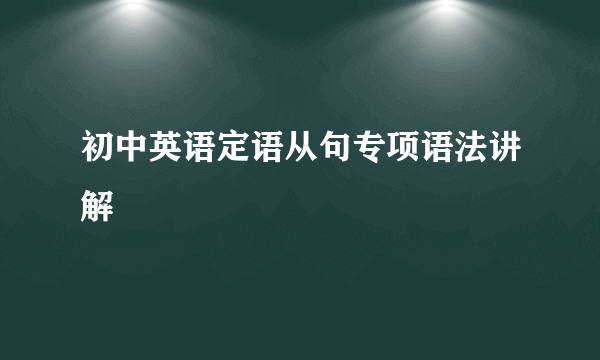限制性定语从句
的有关信息介绍如下:
限制性定语从句 篇1 定语从句可分为限制性和非限制性两种:
1.限制性定语从句(Restrictive attributive clauses):
限制性定语从句,使所修饰的词表示一个特定的人或东西,如果去掉它,那个词就失去意义,句子就不能成立或不完整:
Any one who leaves litter in these woods will beprosecuted.
谁要是在林中乱扔垃圾将受到指控。
这句话如把who引起的定语从句去掉,句子就不能成立。上节例子中的定语从句大部分都是限制性定语从句。只有在这种定语从句中,关系代词才有可能省略。
2.非限制性定语从句(Non—Restrictive Attributive Clauses):
有些定语从句只对某个词作进一步的说明,例如:
She was married to Tony, who was also a student.
这里who引起的就是一个非限定性定语从句,拿掉之后句子还能成立。在一般情况下,非限制性定语从句都由一个逗号把它和句予的其它部分分开,在译成汉语时多译成一个并列句。下面例句中部包含有非限制性定语从句:
The note was left by Jim,who was here a moment ago.
这个条子是吉姆留的,他刚才来过。
She introduced me to her husband,whom I hadn’t met before.
她把我介绍给她丈夫,这人我以前没见过。
This is George,whose class you will be taking.
这是乔治,你将接他的班。
I have many friends,some of whom were painters.
我有许多朋友,其中有些是画家。
She was very fond of speaking French,which indeed shespokewell.
她很喜欢讲法语,而且讲得确实很好。
非限制性定语从句中的关系代词或关系副词是不能省略的,也不能使用关系代词that引导。指物时which用得比较多,有时还可代表更广泛的意思,指人时用who(whom)。
限制性定语从句 篇2
根据定语从句与先行词的关系,定语从句可分为限制性定语从句及非限制性定语从句。限制性定语从句紧跟先行词,主句与从句不用逗号分开,从句不可省去;非限制性定语从句主句与从句之间有逗号分开,起补充说明作用,如省去,意思仍完整。在以上几个单元我们已经学习了限制性定语从句,现在把两种从句作对比学习。
一、 限制性定语从句
1.关系代词that既可代表事物也可代表人,which只代表事物,它们在从句
中作主语或宾语。在从句中作宾语时常可省略。
I was the only person in our office that was invited to the palace ball.
The present that(which)I received last week was from my sister.
This is a book which is about space rocket technology.
2.关系代词who和whom引导的从句用来修饰人,分别作从句中的主语和宾语,whom作宾语时,要注意它可以作动词的宾语也可以作介词的宾语。如:
This is the man who helped me.
The doctor whom you are looking for is in the room.
3. whose是关系代词,修饰名词,作定语,相当于who和whom的所有格,既可以修饰人又可以修饰物。如:
Do you know the student whose name is Wang Fei?
We lived in a room whose window opens to the west.
4. where是关系副词,用来引导表示地点的定语从句,where在从句中作状语。如:
At last we arrived at a small village where we’ll work for a week.
5. when是关系副词,引导定语从句表示时间,在从句中作状语。
注意,表示时间的the time,the day, the moment作先行词,其定语从句引导词有四种情况:1)when,2) in/ on which3) that4)省略。如:
By the time you arrive in London, we will have stayed there for two weeks.
I still remember the day I met her.
Each time he goes to business trip, he brings a lot of living necessities.
6. why是关系副词,引导定语从句表示原因,在从句中作状语。
7.关系副词when, where, why可以用“介词+关系代词”结构代替,但有两点要注意:
1)在“介词+关系代词”结构中,不能用that。关系代词指物用which,指人时用whom,不用who;且which和whom在这个结构中不能省略。如:
The plane in which we flew to Canada is very comfortable. (正确)
The plane in that we flew in to Canada is very comfortable.(错误)
2)在使用介词+关系代词引导的定语从句时,含有介词的动词短语一般不拆开使用,如:look for, look after, take care of等。如“This is the watch which/that I am looking for.”不可以改为“This is the watch for which I am looking.”
二、非限制性定语从句
非限制性定语从句的作用是对所修饰的`成分作进一步说明,通常和主句间用逗号隔开,将从句拿掉后其他部分仍可成立
1. which引导的非限定性定语从句,可用来说明前面整个句子的情况或主句的某一部分。如:
She heard a terrible noise,which brought her heart into her mouth.
David studies hard and is ready to help others,which is what his parents expect.
2.在非限制性定语从句中,不能用that,而用who, whom代表人,用which或as代表事物。关系代词作定语时用whose。如:
He loved his parents deeply, both of whom are very kind to him.
In the basket there are quite many apples, which have gone bad.
There are forty students in our class in all, most of whom are from big cities.限
His mother, who loves him very much, is strict with him.
China, which was founded in 1949, is becoming more and more powerful.
限制性定语从句和非限制性定语从句有时表达的意义不同,试分析下面两个句子的差别:
His brother who is now a doctor always encourages him to go to college.
他那当医生的哥哥常鼓励他要考上大学。(他还有其他的哥哥)
His brother, who is now a doctor, always encourages him to go to college.
他的哥哥是当医生的,常鼓励他要考上大学。(他只有一个哥哥)
3. as和which引导非限制性定语从句
as和which引导非限制性定语从句,有相同之处也有不同之处。具体情况是:
1)As和which都可以在定语从句中做主语或者宾语,代表前面整个句子。
He married her, as/which was natural.
He was honest, as/which we can see.
As we know, smoking is harmful to one's health. The sun heats the earth, which is very important to us.
As we know, smoking is harmful to one’s health.
As is know, smoking is harmful to one’s health.
2)as引导非限制性定语从句,可放在主句之前,或者主句之后,甚至可以
切割一个主句;which引导的非限制性定语从句只能放在主句之后。
As is known to all, China is a developing country.
He is from the south, as we can see from his accent.
John, as you know, is a famous writer.
He has been to Paris more than several times, which I don’t believe.注意:当主句和从句存在逻辑上的因果关系时,常用which
Tom was always late for school, which made his teacher angry.
3)the same… as;such…as是固定结构,意思是“和……一样……。”如:
I have got into the same trouble as he (has).
I have never heard such a story as he tells.
He is not such a fool as he looks.
This is the same book as I lost last week.
注意:当先行次由the same修饰时,偶尔也用that引导定语从句,但是和由as所引导的定语从句意思不同。如:
She wore the same dress that she wore at Mary’s wedding.
她穿着她在玛丽婚礼上穿过的一条裙子。
She wore the same dress as her young sister wore.
她穿着和她妹妹所穿的一样的裙子。
语法专项练习
单项填空
1. The soldier ran to the building, and ____flew a flag.
A. on the top of whichB. on the top of whom
C. on the top of itD. which
2. When the same man ____murdered the old lady entered the hotel once more,
the waiter immediately phoned the police.
A. asB. thatC. whichD. whom
3. He wore, ____was very common at the time, a black jacket.
A. thatB. whichC. itD. what
4. Was it in the room ____Mr. Johnson lived ____the exhibition was held?
A. that; thatB. where; thatC. where; whereD. that; where
5. ____, the population of China is the largest in the world.
A. It is known thatB. As is well known
C. Which is well knownD. We all know that
6. This is the very reason____ he gave me.
A. thatB. whyC. for whichD. which
7. He arrived in New York in 1949, ____, some time later, he became a writer.
A. whenB. whereC. thatD. which
8. They’re talking about the newly opened market, ____you get all ____you need.
A. in which; whichB. where; thatC. where; whichD. which; that
9. She heard a terrible noise, ____brought her heart into her mouth.
A. itB. whichC. thisD. that
10. I said nothing, ____made her angry.
A. whichB. whatC. /D. that
11. I shall never forget the time ____the blacks and whites were fighting side by side.
A. whenB. thatC. /D. A, B and C
12. He has three sons, ____are doctors.
A. two of whomB. both of whomC. all of themD. each of them
13. He tore up my photo, and____ made me angry.
A. thatB. whatC. whichD. who
14. I still remember the sitting-room____ my mother and I sat in last year.
A. whereB. in whichC. thatD. to which
15. The day we looked forward to ____.
A. comeB. comingC. having comeD. has come
答案
1. C。由于and的存在,这是并列句,而不是非限制性定语从句,排除A.
2. B。这里the same修饰man,其后只能用能代表人的关系代词that引导定语从句;whom是宾格,这里引导词要在从句中作主语,故不能用。
3. B。which引导一个非限制性定语从句,which所代表的是整个主句的意思,为了强调从句而提前了。
4. B。识别强调句型不难,但极有可能在第一个空填that,而误选D。其实被强调的部分还含有一个定语从句,修饰room.
5. B。只有as引导的非限制性定语从句可位于主句之前,排除C;若去掉句中的逗号,A项则可构成含有主语从句的复合句,D项则可构成含有宾语从句的复合句。
6. A。强干扰项是B.这里不选why,是因为定语从句缺的是宾语,故用关系代词that.试比较:This is the reason why he gave me so much money;先行词已被very一类的词修饰过了,其后定语从句不用which引导,故亦排除D.
7. B。强干扰项是A.想当然地认为定语从句先行词是时间,事实上,这个非限制性定语从句所修饰的先行词是地点New York,被介词结构分隔了。
8. B。where引导非限制性定语从句,在该定语从句中,不定代词all又带that引导的限制性定语从句。
9. B。从句子结构看,这是个主从复合句,故不用it和this;引导非限制性定语从句不用that.
10. A。如果只想当然地认为nothing是不定代词,其后的定语从句要用that引导,就错了。这里是一个非限制性定语从句,应该用which引导,并且which所代表的是整个主句的意思。
11. D。英语中少数几个与时间有关的名词,如the time, the day, the moment作先行词,所带定语从句的引导词可用that代替when,也可以省略。
12. A。如果看出这是个定语从句,C、D很容易排除。Both of whom中的whom指两个,数量是2/2;two of whom, whom指三人,数量是2/3.
13. A。强干扰项是C,因为有and,这是并列句,不是非限制性定语从句。这里that是指示代词,作主语。
14. C。如果错误地把后面的介词in理解为in last year,可能误选A、B.事实上,in与前边的关系代词that引导定语从句。Last year是名词词组作时间状语,不加冠词。
15. D。这里“(that/which) we looked forward to”是修饰the day的定语从句;to的宾语是省略了的引导词。
限制性定语从句 篇3
1、限制性定语从句是对先行词的内容进行严格、明确限定的定语从句,与先行词的意思关系非常紧密。
2、此时如果把限制性从句移除,先行词的意思就会受影响,意思不完整、不清楚或者有很大的变化。所以,限制性定语从句是不能移除的。
限制性定语从句只能用that 的几种情况
1.当先行词是anything, everything, nothing (something 除外), few, all, none, little, some 等代词时, 或者是由every, any, all, some, no, little, few, much 等修饰时
(1) Have you taken down everything that Mr.Li has said?
(2) There seems to be nothing that seems impossible for him in the world.
(3) All that can be done has been done.
(4) There is little that I can do for you.
注意:当先行词指人时, 偶尔也可以用who
(4) Any man that/.who has a sense of duty won't do such a thing.
2.当先行词被序数词修饰
(1) The first place that they visited in London was the Big Ben.
3.当先行词被形容词最高级修饰时
(1) This is the best film that I have seen.
4.当形容词被the very, the only修饰时
(1) This is the very dictionary that I want to buy,
(2) After the fire in his house,the old car is the only thing that he owned.
当先行词指人时, 偶尔也可以用who
(3) Wang Hua is the only person in our school who will attend the meeting/
5.当先行词前面有who, which等疑问代词时
(1) Who is the man that is standing there?
(2) Which is the T-shirt that fits me most?
6.当先行词既有人, 也有动物或者物体时
(1) Can you remember the scientist and his theory that we have learned?
限制性定语从句 篇4
which引导的非限制性定语从句(也引导限制性定语从句):
which引导的非限制性定语从句既可以指整个句子的内容,也可以指句子的部分内容(如单词或词组等),在句子中可以作主语、宾语(动词或介词的)、定语等。注意它在句子中的位置:只能放在主句后,不能放在主句前。表达的内容是“不好的”、“事先没有预料到的”等时,常用which,只指物。
Yellowstone National Park,which is in Wyoming,is one of the most beautiful national parks in the world.
黄石国家公园位于怀俄明州,是世界上最美丽的国家公园之一。
The clock,which my grandfather bought,is still in good order.
这时钟是我祖父买的,现在还走得很准时。
The picture,for which he paid an enormous amount of money,was a forgery.
那幅画他花了一大笔钱购买,却是幅赝品。
I lived three years in Paris,during which time I learned French.
我在巴黎住了三年,在那期间我学了法语。
限制性定语从句 篇5
1. as引导限制性定语从句的主要结构有:the same…as;as…as;such…as;so…as。主句中出现the same, as, such, so修饰先行词,需选择as做关系代词在定语从句中做主语或宾语。例,It’s the same person as we wanted to find yesterday .
2、as引导非限制性定语从句,指代整个主句内容,从句可置于句首,句中或句尾。
例:As everyone knows ,China is a beautiful country with a long history .
3、非限制性定语从句中的谓语为被动式时,常用as做主语。
例:besaid/known/announced/reported/mentioned/expected/discussed



